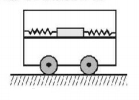Question
Two springs, each of spring constant $$k = 100\,N/m,$$ are attached to a block of mass $$2\,kg$$ as shown in the figure. The block can slide smoothly along a horizontal platform clamped to the opposite walls of the trolley of mass $$5\,kg.$$ If the block is displaced by $$x\,cm.$$ and released, the period of oscillation in seconds is
Two springs, each of spring constant $$k = 100\,N/m,$$ are attached to a block of mass $$2\,kg$$ as shown in the figure. The block can slide smoothly along a horizontal platform clamped to the opposite walls of the trolley of mass $$5\,kg.$$ If the block is displaced by $$x\,cm.$$ and released, the period of oscillation in seconds is

A.
$$T = 2\pi \sqrt {\frac{1}{{20}}} $$
B.
$$T = 2\pi \sqrt {\frac{7}{{1000}}} $$
C.
$$T = 2\pi \sqrt {\frac{1}{{140}}} $$
D.
$$T = 2\pi \frac{{49}}{{100}}$$
Answer :
$$T = 2\pi \sqrt {\frac{1}{{140}}} $$
Solution :
$$\eqalign{ & T = 2\pi \sqrt {\frac{\mu }{{2k}}} \,\,\because \mu = \frac{{{m_1}{m_2}}}{{{m_1} + {m_2}}} \cr & T = 2\pi \sqrt {\frac{{10}}{{7 \times 200}}} = \frac{{2 \times 5}}{7} = \frac{{10}}{7} = 2\pi \sqrt {\frac{1}{{140}}} \cr} $$
$$\eqalign{ & T = 2\pi \sqrt {\frac{\mu }{{2k}}} \,\,\because \mu = \frac{{{m_1}{m_2}}}{{{m_1} + {m_2}}} \cr & T = 2\pi \sqrt {\frac{{10}}{{7 \times 200}}} = \frac{{2 \times 5}}{7} = \frac{{10}}{7} = 2\pi \sqrt {\frac{1}{{140}}} \cr} $$